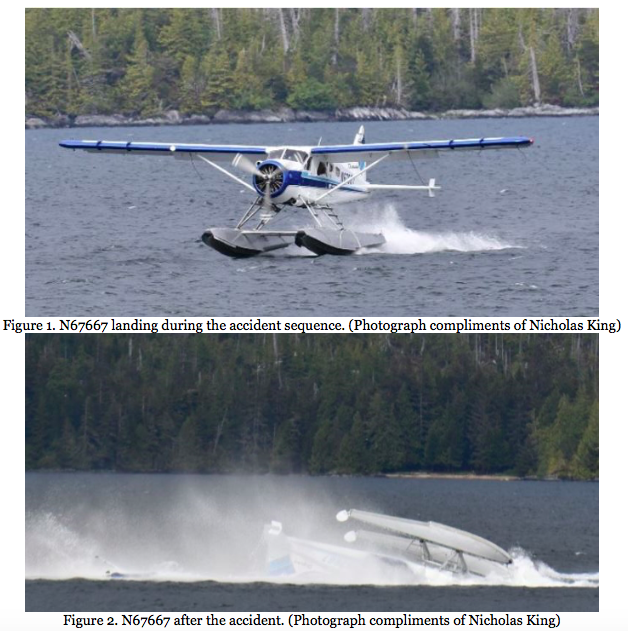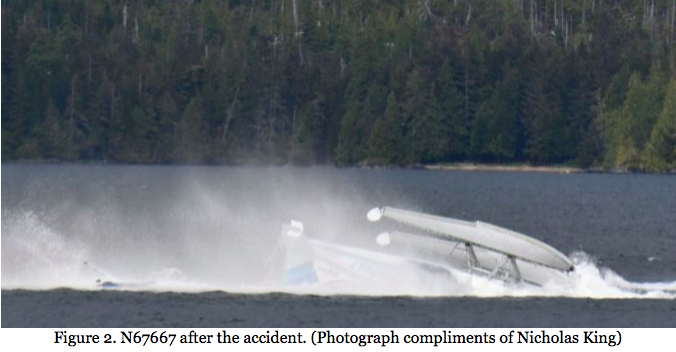The National Safety and Transportation Board preliminary investigation into the May 20 deadly crash of a floatplane in Metlakatla shows that the pilot had little experience with floats — just five hours when hired.
The two fatalities were the pilot and the passenger.
Taquan Air, which operated the plane, also had a plane involved in a midair collision near Ketchikan on May 14. Six people died in that accident, and 10 were injured. In that instance, both of the planes were flying over George Inlet, eight nautical miles from Ketchikan, when they tangled in midair.
[Watch the NTSB briefing on the May 14 midair collision here]
Here’s the NTSB preliminary report in full for the May 20 crash in Metlakatla:
On May 20, 2019, about 1556 Alaska daylight time, a float-equipped de Havilland DHC-2 (Beaver) airplane, N67667, overturned and partially sank during a landing in Metlakatla Harbor, Metlakatla, Alaska. The commercial pilot and passenger sustained fatal injuries, and the airplane sustained substantial damage. The airplane was registered to Blue Aircraft, LLC and operated by Venture Travel, LLC, dba Taquan Air, Ketchikan, Alaska, under the provisions of Title 14 Code of Federal Regulations Part 135 as a scheduled commuter flight. Company flight following procedures were in effect and visual meteorological conditions prevailed. The flight originated from the Ketchikan Harbor Seaplane Base (5KE), Ketchikan, about 1540 as Flight 20, and was destined for the Metlakatla Seaplane Base (MTM) in Metlakatla.
According to company dispatch documents, Flight 20 was a scheduled flight with one passenger, U.S. mail, freight and packages destined for Metlakatla, which is a community on Annette Island about 16 miles southeast of Ketchikan.
A preliminary review of archived Federal Aviation Administration (FAA) air traffic control track data revealed that after departure from Ketchikan, the flight traveled southeast over an area known as the Tongass Narrows, then south to Metlakatla Harbor. The end of the flight track indicated a right turn to a westward track in the southern portion of the harbor.
Three eyewitnesses provided statements to the National Transportation Safety Board (NTSB) investigator-in-charge (IIC). All three witnesses reported that the airplane made a normal approach to the water, in a westerly direction.
Two of the witnesses awaiting the arrival of Flight 20, stated that before touchdown on the surface of the water, the wings rocked to the left, and then to the right. One of the witnesses observed the right wing strike the surface of the water, and the airplane nosed over rapidly. After the airplane nosed over, the cockpit and cabin partially sank. The third witness, who was in a fishing vessel north of the accident site, said that as he watched the airplane land, he observed the right float “dig into the water” and then the airplane nosed over.
One of the witnesses photographed the approach, initial touch down, and post-accident events. Refer to figures 1 and 2.

Two boats in the area immediately responded, followed by a Metlakatla Police vessel with volunteer emergency medical technicians (EMTs) onboard. According to statements provided by the first responders, the airplane’s empennage was hoisted slightly out of the water by the fishing vessel, and good Samaritans together with the EMTs removed airplane seats, mail, packages and cargo netting. The occupants were removed from the airplane and transported to the Annette Island Health Center where they were declared deceased.
On May 21, during the NTSB IIC’s on scene examination of the wreckage, it was revealed that the right wing and right lift strut separated from the fuselage in a rearward direction. Witnesses stated that the right wing and strut sank, as well as the passenger’s seat after removal, and those components remain missing. All other major aircraft components were intact and accounted for. Several avionics components were subsequently recovered from the wreckage and sent to the NTSB Vehicle Recorders Laboratory in Washington, D.C. for further examination.
According to Taquan Air management personnel, the accident pilot was a new seasonal pilot hired for the 2019 season, and he held a commercial pilot certificate with airplane single-engine land, single-engine sea, and instrument airplane ratings. According to the operator, when the pilot started company orientation on April 22, he had a total of 1,606 flight hours, of which 5 hours were in float-equipped airplanes. He completed the company CFR Part 135.293 and 135.299 check rides in a float-equipped DHC-2 on May 3, and he completed CFR Part 135.244 initial operation experience requirements on May 11, 2019.
The closest weather reporting facility is located at the Annette Island Airport (PANT), about 6 miles south of the accident site. At 1553 an aviation routine weather report (METAR) reported wind from 160° at 10 knots, visibility 10 statute miles, ceiling and cloud cover clear, temperature 55° F, dew point 48° F, and altimeter 29.71 inches of mercury. Witnesses near the accident site stated that the wind conditions were from the southeast, from the direction of Purple Mountain, at 13 to 15 mph, and that the water conditions were less than choppy.

Only 5 hours on floats?
He need at least 5 hours to get his float plane rating. Then he needed additional flight training for the air taxi service.
He had 5 hours when he was first hired.
How many hours piloting a float plane did the pilot have when he crashed?
Typically, 80%+ of small aircraft, especially float plane, accidents are due to “pilot error”, not mechanical malfunction. When the “season” begins, most experienced, qualified Alaskan pilots are already working. This leaves little option for the air-taxi owners, except hiring inexperienced pilots, possessing only a piece of paper (FAA certification), not experience, certifying their ability to be a competent pilot in Alaska. Alaska has some of the most difficult terrain for flying, in the country. Special training should be required to deal with this. Also, notice in the first picture of the “Beaver” landing, that the right float is mounted with an apparent lower angle on the front of the float, compared to the left float. The wings appear level but the floats do not. Maybe a photographic difference, only, but it doesn’t look like it. An experienced pilot would note this difference and make adjustments to his landing procedure. I’m not saying that’s the reason, only that it may have contributed to the accident.
I offer my condolences to the pilot and passenger’s families.
Ben… looks like left pontoon on water with right rudder. what’s your take?
Robert,
It looks that way, all right. Probably compensating for the crosswind coming from the right. Also, notice the spray from the back of the floats. Appears to be blowing from the right side of the airplane to the left. Whatever the case, I don’t claim to be an expert, by any means. Just commenting from experience. No excuse to make a crosswind landing on floats, unless you’re on a river, limited landing area or an inexperienced pilot. If you notice the rudder angle on the tail, it also is slightly canted towards turning right.
Also, usually, unless inexperienced, the water rudders aren’t lowered until the aircraft is firmly on the water.
Wonder if floated off in and then out of ground effect, stalled and dipped the wing? Much conjecture, but results were final.
Robert,
You may very well be correct. However, “Beavers” and ” Single engine Otters” are known to have a little trouble in crosswind landings. The wing designs are terrific for “lift” into a direct headwind, but have some trouble in crosswind applications, especially landing. Experienced pilots are aware of this. If you notice, in the picture I mentioned, there appears, from the direction of the wavelets, to be a crosswind coming from the right side of the aircraft. Typically, the upwind wing loses a portion of it’s lift in any crosswind, on this aircraft. That, together with, even slightly misaligned float mounting, is a recipe for accidents.
so…potential over correction of left wing dipping and PIO?
Why is Taquan Air still allowed to fly? Two incidents in less than a month? Prior incidents in previous years. They’re doing nothing to foster confidence in themselves or others in them.
Remember people don’t like regulations; and the cost is heavy in accidents, environment and all other areas that are suppose to protect the commons when regulations are relaxed
How can a pilot with a license to learn with 5 hrs experience on floats be allowed to conduct flying like this one. Obviously company rules are to be reviewed and company should be grounded until further.
The NTSB report says: “According to the operator, when the pilot started company orientation on April 22, he had a total of 1,606 flight hours, of which 5 hours were in float-equipped airplanes.“ This means he had five hours of float time in April, not when he flew his last flight, as this headline states.
Pilots leave float school with five hours of float time. This was obviously his first job as a floats guy, but that doesn’t mean the company cut him loose without additional floats training. Every company puts their pilots through additional training, a checkride, initial operator experience. Not saying Taquan doesn’t have issues or that this guy may not have been cut loose too soon, but this headline is misleading and will cause many people to assume it is correct, doing perhaps greater damage to the reputation of the company and pilot than is deserved. The worst thing most pilots can think of is being responsible for the death of a passenger. This misleading headline really irks me because it is inflammatory and perhaps does not do justice. Suzanne can do better than this.
“All three witnesses reported that the airplane made a normal approach to the water, in a westerly direction.”
If the airplane was flying due west then it would have a heading of 270 degrees.
.
The weather reporting facility (6 miles south of the accident site) reported wind from 160° at 10 knots, which is from the southeast. “Witnesses near the accident site stated that the wind conditions were from the southeast, from the direction of Purple Mountain, at 13 to 15 mph…”.
This would seem to indicate that the wind was blowing toward the left side of the airplane and a little from behind. It seems to me that the plane should have been landing straight into the wind. That means towards the southeast, toward 160 degrees. It seems to me, that would have allowed him to have a slower approach speed relative to the water, and a path on the water that is more parallel to the longitudinal axis of the airplane, so that the floats won’t hit the water with a partial sideways component..
.
Also, landing straight into the wind avoids a crosswind, which can cause the wingtips to bounce up and down a bit, like a teetertotter.
I’ve read all the comments and to me, it was a terrible thing to happen. Experienced or not, its a gut wrenching accident and my heart and prayers go out to everyone involved!!!!
Comments are closed.